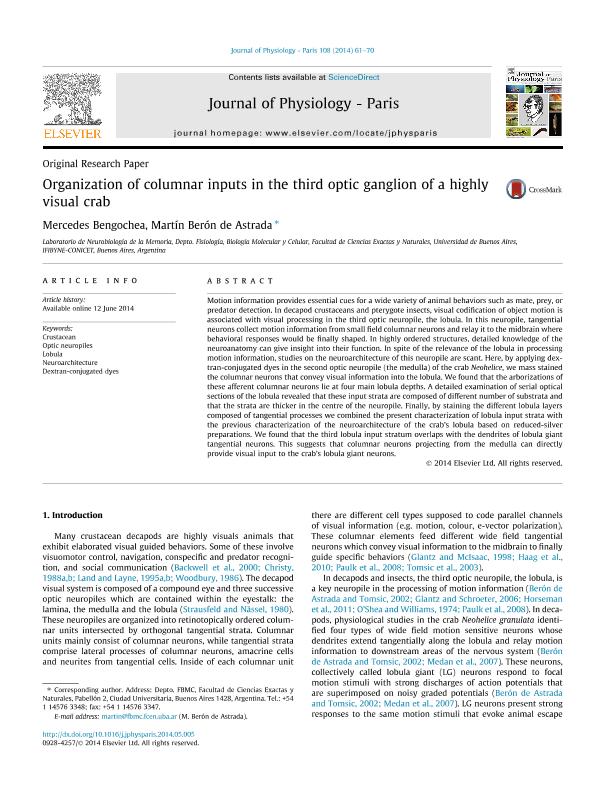Mostrar el registro sencillo del ítem
dc.contributor.author
Bengochea, Mercedes

dc.contributor.author
Berón de Astrada, Martín

dc.date.available
2017-07-11T20:38:31Z
dc.date.issued
2014-06
dc.identifier.citation
Bengochea, Mercedes; Berón de Astrada, Martín; Organization of columnar inputs in the third optic ganglion of a highly visual crab; Elsevier; Journal of Physiology; 108; 2-3; 6-2014; 61-70
dc.identifier.issn
0928-4257
dc.identifier.uri
http://hdl.handle.net/11336/20175
dc.description.abstract
Motion information provides essential cues for a wide variety of animal behaviors such as mate, prey, or predator detection. In decapod crustaceans and pterygote insects, visual codification of object motion is associated with visual processing in the third optic neuropile, the lobula. In this neuropile, tangential neurons collect motion information from small field columnar neurons and relay it to the midbrain where behavioral responses would be finally shaped. In highly ordered structures, detailed knowledge of the neuroanatomy can give insight into their function. In spite of the relevance of the lobula in processing motion information, studies on the neuroarchitecture of this neuropile are scant. Here, by applying dextran-conjugated dyes in the second optic neuropile (the medulla) of the crab Neohelice, we mass stained the columnar neurons that convey visual information into the lobula. We found that the arborizations of these afferent columnar neurons lie at four main lobula depths. A detailed examination of serial optical sections of the lobula revealed that these input strata are composed of different number of substrata and that the strata are thicker in the centre of the neuropile. Finally, by staining the different lobula layers composed of tangential processes we combined the present characterization of lobula input strata with the previous characterization of the neuroarchitecture of the crab’s lobula based on reduced-silver preparations. We found that the third lobula input stratum overlaps with the dendrites of lobula giant tangential neurons. This suggests that columnar neurons projecting from the medulla can directly provide visual input to the crab’s lobula giant neurons.
dc.format
application/pdf
dc.language.iso
eng
dc.publisher
Elsevier

dc.rights
info:eu-repo/semantics/openAccess
dc.rights.uri
https://creativecommons.org/licenses/by-nc-nd/2.5/ar/
dc.subject
Visión
dc.subject
Artropodos
dc.subject
Sistema Visual
dc.subject
Morfologia
dc.subject.classification
Otros Tópicos Biológicos

dc.subject.classification
Ciencias Biológicas

dc.subject.classification
CIENCIAS NATURALES Y EXACTAS

dc.title
Organization of columnar inputs in the third optic ganglion of a highly visual crab
dc.type
info:eu-repo/semantics/article
dc.type
info:ar-repo/semantics/artículo
dc.type
info:eu-repo/semantics/publishedVersion
dc.date.updated
2017-07-11T19:27:27Z
dc.journal.volume
108
dc.journal.number
2-3
dc.journal.pagination
61-70
dc.journal.pais
Países Bajos

dc.journal.ciudad
Amsterdam
dc.description.fil
Fil: Bengochea, Mercedes. Consejo Nacional de Investigaciones Científicas y Técnicas. Oficina de Coordinación Administrativa Ciudad Universitaria. Instituto de Fisiología, Biología Molecular y Neurociencias. Universidad de Buenos Aires. Facultad de Ciencias Exactas y Naturales. Instituto de Fisiología, Biología Molecular y Neurociencias; Argentina
dc.description.fil
Fil: Berón de Astrada, Martín. Consejo Nacional de Investigaciones Científicas y Técnicas. Oficina de Coordinación Administrativa Ciudad Universitaria. Instituto de Fisiología, Biología Molecular y Neurociencias. Universidad de Buenos Aires. Facultad de Ciencias Exactas y Naturales. Instituto de Fisiología, Biología Molecular y Neurociencias; Argentina
dc.journal.title
Journal of Physiology

dc.relation.alternativeid
info:eu-repo/semantics/altIdentifier/doi/http://dx.doi.org/10.1016/j.jphysparis.2014.05.005
dc.relation.alternativeid
info:eu-repo/semantics/altIdentifier/url/http://www.sciencedirect.com/science/article/pii/S0928425714000229
Archivos asociados
